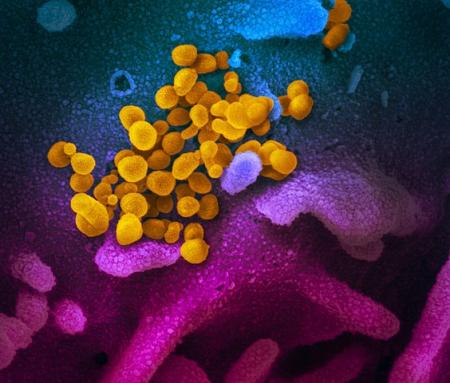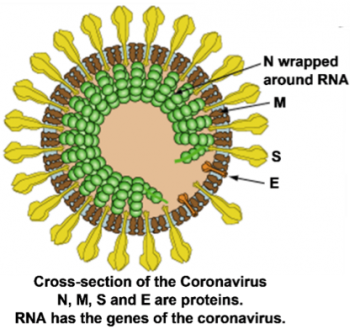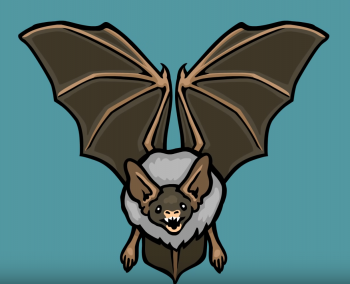Serendip is an independent site partnering with faculty at multiple colleges and universities around the world. Happy exploring!
Resources for Teaching about Coronavirus
 Our understanding of the novel coronavirus and the COVID-19 pandemic continues to change rapidly. The following resources for teaching high school biology students are up-to-date as of November 2022. Previously provided resources are available at (Archived).
Our understanding of the novel coronavirus and the COVID-19 pandemic continues to change rapidly. The following resources for teaching high school biology students are up-to-date as of November 2022. Previously provided resources are available at (Archived).
On this page:
- Coronavirus Learning Activities
- Ongoing Sources of Reliable New Information
- How to Turn Information Sources into Learning Activities
Learning Activities
For the first three learning activities listed below, the links lead to Student Handouts (available in Word, PDF, and as a Google doc) and Teacher Notes that include instructional suggestions, background information, links to additional sources of information, and an explanation of how each activity is aligned with the Next Generation Science Standards (#NGSS).
 Coronaviruses – What They Are and How They Can Make You Sick
Coronaviruses – What They Are and How They Can Make You Sick
https://serendipstudio.org/exchange/bioactivities/coronavirusintro
In the shorter version of the Student Handout, students learn how coronaviruses are replicated inside our cells, how white blood cells fight a coronavirus infection, and how a coronavirus infection can cause you to feel sick. In the longer version of the Student Handout, students also learn how the respiratory and circulatory systems work together to provide oxygen to the body’s cells, and they learn how a coronavirus infection can interfere with oxygen delivery, which can result in severe disease.
COVID-19 Vaccines – How do they work?
https://serendipstudio.org/exchange/bioactivities/coronavirusvaccine
Students begin by proposing a hypothesis to explain why the risk of COVID-19 is substantially lower for people who have been vaccinated and for people who have previously had COVID-19. Students analyze how the immune system responds to a coronavirus infection and how this response differs after a first vs. second exposure to the coronavirus. Then, students analyze the biological effects of an mRNA vaccine and revise their hypotheses about how a vaccine protects against illness.
 Coronavirus Evolution and the COVID-19 Pandemic
Coronavirus Evolution and the COVID-19 Pandemic
https://serendipstudio.org/exchange/bioactivities/coronavirusOrigin
In this analysis and discussion activity, students learn that the coronavirus responsible for the current pandemic very probably originated in bats. Students analyze how mutations and natural selection can produce a spillover infection. Next, students learn how natural selection increased the frequency of a mutation that made the coronavirus more contagious. Finally, students analyze how mutations contributed to the spread of the Omicron variant.
Biology of SARS CoV-2
https://www.biointeractive.org/classroom-resources/biology-sars-cov-2
This three-part animation series explores the biology of the virus SARS-CoV-2, which has caused a global pandemic of the disease COVID-19. The first animation, Infection, describes the structure of coronaviruses like SARS-CoV-2 and how they infect humans and replicate inside cells. The second animation, Evolution, describes how these viruses evolve and discusses positive, negative, and neutral mutations. The third animation, Detection, describes the methods used to detect active and past SARS-CoV-2 infections. The accompanying “Student Worksheets” incorporate concepts and information from the animations.
The Science of COVID-19
https://www.covid19.csats.psu.edu/
This is a sophisticated, college-level curriculum. Module 1, Virology, includes lessons on “A New Virus” and “Vaccines”. In the first lesson, students learn how to isolate and classify a new virus and confirm the classification using a bioinformatics tool. In the lesson on vaccines, students analyze models to make inferences about molecular interactions and learn about the process of vaccine development. In Module 2, students learn how to model infectious disease spread. Module 3 introduces students to public health considerations.
Pandemic Pandemonium – Why can’t we just treat COVID-19?
https://www.nsta.org/ncss-case-study/pandemic-pandemonium
This directed case study was designed to serve as a capstone project incorporating aspects of nucleic acid, lipid and protein structure and function, central dogma, and virus life cycles. Students explore the differences between SARS-CoV-2, which causes COVID-19, and other viruses like herpes, influenza and HIV. They examine the structure of SARS-CoV-2 and how it binds to and enters a cell. They consider the genome of SARS-CoV-2, which consists of RNA-based nucleic acids, and its mechanism of translation. One of the girls in the story tests positive for COVID-19 and her parents consider multiple antiviral treatments approved for influenza, HIV and herpes. Students then research the mechanism of action of these antivirals, suggest why they will not be successful in treating COVID-19, and predict possible antiviral targets specific for SARS-CoV2. (Other case study learning activities related to COVID-19 can be found by using the search function at https://www.nsta.org/case-studies.)
COVID-19 Curriculum Materials
https://epiclearning.web.unc.edu/covid/
EPIC Learning has collected several activities in which students model the spread of coronavirus infection and develop media literacy.
SARS-CoV-2 & Covid-19 Lesson Plan & Resources
https://docs.google.com/document/d/1HQXXH5vOZflLe9AoaPgp1NKLonSpe87DovMO1vdTH8k/edit
This document provides links for multiple curriculum units and helpful sources of information.
COVID-19 Science Spotlight
https://www.exploratorium.edu/learn/covid
Sections on “Viruses and Us” and “Personal and Social Behavior” provide multiple activities and videos related to the COVID-19 pandemic.
Ongoing Sources of Reliable New Information
Reliable sources of new information include:
- CDC (https://www.cdc.gov/coronavirus/2019-ncov/index.html)
- Science (https://www.sciencenews.org/editors-picks/2019-novel-coronavirus-outbreak)
- New York Times (https://www.nytimes.com/news-event/coronavirus)
How to Turn Information Sources into Learning Activities
You can convert the information sources listed above to learning activities by providing your students with appropriate questions. A more ambitious approach would be to use the following steps to carry out a jigsaw activity using several of the articles on the same topic or related topics.2
- Tell your class that they will read one article in their small group, summarize the main conclusions and evidence, and then share this information with a group of students who have read other articles.
- As students complete the reading individually, each of them should prepare a summary and possibly annotate the article and/or answer any questions that you may have prepared.
- Have students who read the same article briefly share their findings with one another and discuss the article. This will help students prepare to briefly summarize their article in the mixed group.
- Regroup students so that one representative from each article is in each group. Ask students to briefly summarize their articles in their new groups. When sharing the summaries, students should make connections to what they have heard in the other students’ summaries. They should talk through anything that is unclear or seems inconsistent from one article to the next. Students should take notes during this sharing, listening, and discussion process.
- The whole class then discusses the main takeaways from the jigsaw reading. Ask students what questions they are still wondering about and try to follow up.
1 Previously provided resources are available at Archived 12/2020 and Archived 6/2020.
2 These instructions are adapted from https://www.nsta.org/science-teacher/science-teacher-march-2020/novel-coronavirus.
- Login to post comments
-











